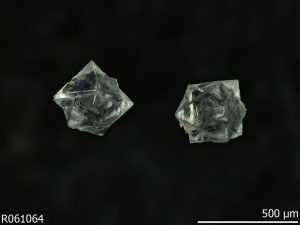
With high-pressure experiments at DESY’s X-ray light source PETRA III and other facilities, a research team around Leonid Dubrovinsky from the University of Bayreuth has solved a long standing riddle in the analysis of meteorites from Moon and Mars. The study, published in the journal Nature Communications, can explain why different versions of silica can coexist in meteorites, although they normally require vastly different conditions to form. The results also mean that previous assessments of conditions at which meteorites have been formed have to be carefully re-considered.
The scientists investigated a silicon dioxide (SiO2) mineral that is called cristobalite. “This mineral is of particular interest when studying planetary samples, such as meteorites, because this is the predominant silica mineral in extra-terrestrial materials,” explains first author Ana Černok from Bayerisches Geoinstitut (BGI) at University Bayreuth, who is now based at the Open University in the UK. “Cristobalite has the same chemical composition as quartz, but the structure is significantly different,” adds co-author Razvan Caracas from CNRS, ENS de Lyon.
Different from ubiquitous quartz, cristobalite is relatively rare on Earth’s surface, as it only forms at very high temperatures under special conditions. But it is quite common in meteorites from Moon and Mars. Ejected by asteroid impacts from the surface of Moon or Mars, these rocks finally fell to Earth.
Surprisingly, researchers have also found the silica mineral seifertite together with cristobalite in Martian and lunar meteorites. Seifertite was first synthesised by Dubrovinsky and colleagues 20 years ago and needs extremely high pressures to form. “Finding cristobalite and seifertite in the same grain of meteorite material is enigmatic, as they form under vastly different pressures and temperatures,” underlines Dubrovinsky. “Triggered by this curious observation, the behaviour of cristobalite at high-pressures has been examined by numerous experimental and theoretical studies for more than two decades, but the puzzle could not be solved.”
Using the intense X-rays from PETRA III at DESY and the European Synchrotron Radiation Facility ESRF in Grenoble (France), the scientists could now get unprecedented views at the structure of cristobalite under high pressures of up to 83 giga-pascals (GPa), which corresponds to roughly 820,000 times the atmospheric pressure. “The experiments showed that when cristobalite is compressed uniformly or almost uniformly — or as we say, under hydrostatic or quasi-hydrostatic conditions — it assumes a high-pressure phase labelled cristobalite X-I,” explains DESY co-author Elena Bykova who works at the Extreme Conditions Beamline P02.2 at PETRA III, where the experiments took place. “This high-pressure phase reverts back to normal cristobalite when the pressure is released.”
But if cristobalite is compressed unevenly under what scientists call non-hydrostatic conditions, it unexpectedly converts into a seifertite-like structure, as the experiments have now shown. This structure forms under significantly less pressure than necessary to form seifertite from ordinary silica. “The ab initio calculations confirm the dynamical stability of the new phase up to high pressures,” says Caracas. Moreover it also remains stable when the pressure is released.
“This came as a surprise,” says Černok. “Our study clarifies how squeezed cristobalite can transform into seifertite at much lower pressure than expected. Therefore, meteorites that contain seifertite associated with cristobalite have not necessarily experienced massive impacts.” During an impact, the propagation of the shock wave through the rock can create very complex stress patterns even with intersecting areas of hydrostatically and non-hydrostatically compressed materials, so that different versions of silica can form in the same meteorite.
“These results have immediate implications for studying impact processes in the solar system,” underlines Dubrovinsky. “They provide clear evidence that neither cristobalite nor seifertite should be considered as reliable tracers of the peak shock conditions experienced by meteorites.” But the observations also show more generally that the same material can react very differently to hydrostatic and non-hydrostatic compression, as Dubrovinsky explains. “For materials sciences our results suggest an additional mechanism for the manipulation of the properties of materials: Apart from pressure and temperature, different forms of stress may lead to completely different behaviour of solid matter.”
Reference:
Ana Černok, Katharina Marquardt, Razvan Caracas, Elena Bykova, Gerlinde Habler, Hanns-Peter Liermann, Michael Hanfland, Mohamed Mezouar, Ema Bobocioiu, Leonid Dubrovinsky. Compressional pathways of α-cristobalite, structure of cristobalite X-I, and towards the understanding of seifertite formation. Nature Communications, 2017; 8: 15647 DOI: 10.1038/ncomms15647
Note: The above post is reprinted from materials provided by Deutsches Elektronen-Synchrotron DESY.









